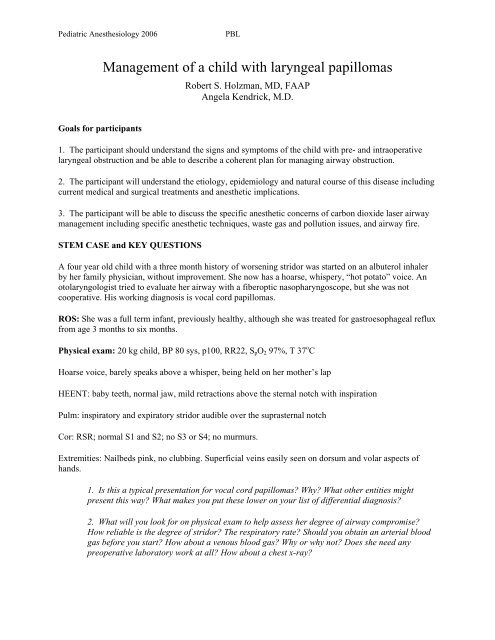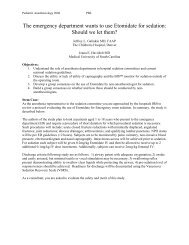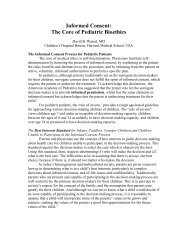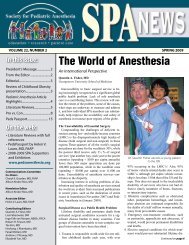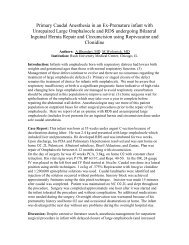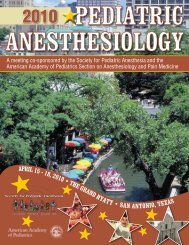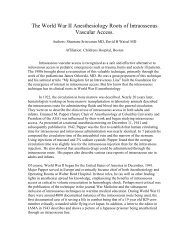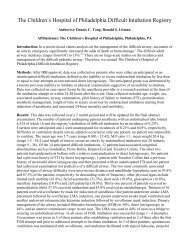management of a child with laryngeal papillomas - The Society for ...
management of a child with laryngeal papillomas - The Society for ...
management of a child with laryngeal papillomas - The Society for ...
Create successful ePaper yourself
Turn your PDF publications into a flip-book with our unique Google optimized e-Paper software.
Pediatric Anesthesiology 2006PBLManagement <strong>of</strong> a <strong>child</strong> <strong>with</strong> <strong>laryngeal</strong> <strong>papillomas</strong>Robert S. Holzman, MD, FAAPAngela Kendrick, M.D.Goals <strong>for</strong> participants1. <strong>The</strong> participant should understand the signs and symptoms <strong>of</strong> the <strong>child</strong> <strong>with</strong> pre- and intraoperative<strong>laryngeal</strong> obstruction and be able to describe a coherent plan <strong>for</strong> managing airway obstruction.2. <strong>The</strong> participant will understand the etiology, epidemiology and natural course <strong>of</strong> this disease includingcurrent medical and surgical treatments and anesthetic implications.3. <strong>The</strong> participant will be able to discuss the specific anesthetic concerns <strong>of</strong> carbon dioxide laser airway<strong>management</strong> including specific anesthetic techniques, waste gas and pollution issues, and airway fire.STEM CASE and KEY QUESTIONSA four year old <strong>child</strong> <strong>with</strong> a three month history <strong>of</strong> worsening stridor was started on an albuterol inhalerby her family physician, <strong>with</strong>out improvement. She now has a hoarse, whispery, “hot potato” voice. Anotolaryngologist tried to evaluate her airway <strong>with</strong> a fiberoptic nasopharyngoscope, but she was notcooperative. His working diagnosis is vocal cord <strong>papillomas</strong>.ROS: She was a full term infant, previously healthy, although she was treated <strong>for</strong> gastroesophageal refluxfrom age 3 months to six months.Physical exam: 20 kg <strong>child</strong>, BP 80 sys, p100, RR22, S p O 2 97%, T 37 o CHoarse voice, barely speaks above a whisper, being held on her mother’s lapHEENT: baby teeth, normal jaw, mild retractions above the sternal notch <strong>with</strong> inspirationPulm: inspiratory and expiratory stridor audible over the suprasternal notchCor: RSR; normal S1 and S2; no S3 or S4; no murmurs.Extremities: Nailbeds pink, no clubbing. Superficial veins easily seen on dorsum and volar aspects <strong>of</strong>hands.1. Is this a typical presentation <strong>for</strong> vocal cord <strong>papillomas</strong>? Why? What other entities mightpresent this way? What makes you put these lower on your list <strong>of</strong> differential diagnosis?2. What will you look <strong>for</strong> on physical exam to help assess her degree <strong>of</strong> airway compromise?How reliable is the degree <strong>of</strong> stridor? <strong>The</strong> respiratory rate? Should you obtain an arterial bloodgas be<strong>for</strong>e you start? How about a venous blood gas? Why or why not? Does she need anypreoperative laboratory work at all? How about a chest x-ray?
Pediatric Anesthesiology 2006PBLShe cries when she sees you. Mom says she heard from her family physician that you would premedicateher <strong>child</strong> so she would not have post traumatic stress disorder.3. Will you premed this anxious <strong>child</strong>? Why? If so, how? If not, why not?4. Will you start an IV be<strong>for</strong>e you begin her anesthetic induction? Why? Will you use the IV <strong>for</strong>induction? Does this patient need any additional intravenous medications prior to induction?Which ones? Why?Her surgeon arrives and says he’d first like to take a look at her airway once she is anesthetized andbreathing spontaneously. If he sees <strong>papillomas</strong>, he’s planning to use the CO 2 laser <strong>for</strong> the case.5. How should the OR prepare <strong>for</strong> a CO 2 laser case? What safety materials should the OR teamhave readily available? Why? Are there any preparations the surgeon must make?6. Once you are in the operating room <strong>with</strong> the <strong>child</strong>, you begin an inhalation induction. Whichagents will you choose? Why? Is there any advantage to using nitrous oxide when you areplanning a sev<strong>of</strong>lurane induction? Why / why not?Her sternal retraction worsens after about one minute, and you don’t feel she is moving any air.7. Why do you think this is happening? Now what? What steps might you take to relieve theairway obstruction that has occurred during induction? Anything else you want to do? Whatabout a nasal airway? Oral airway? LMA? CPAP? Muscle relaxant (if so, which one?)Your maneuvers were successful, and you continue to deepen the inhaled anesthetic.8. What is your end point? How do you know when she is “deep?” Why is that importantanyway? Would a BIS monitor help in this regard? Why or why not?You turn the OR table 90 degrees and the surgeon positions (suspends) the <strong>child</strong> <strong>for</strong> laryngoscopy.9. Will you intubate prior to suspension? Why / why not? Is this age-dependent? Any othercriteria you use?10. What anesthetic technique will you use? Specific anesthetic agents? Will you use totalintravenous anesthesia? If so, which agents will you choose? Can you do this and maintainspontaneous ventilation? What about dexmedetomidine? If you plan to deliver inhaled agents,how will you do this? How will you scavenge waste gas? What F i O 2 will you choose? Why?Laryngoscopy confirms many <strong>papillomas</strong> above and on the vocal cords. In fact, it is difficult to see thevocal cords because <strong>of</strong> the extensive grape-like mass. <strong>The</strong> patient begins to cough and desaturate.11. Now what? Why? What is the quickest way to deepen the anesthetic? Is this the same as thequickest way to stop the patient from coughing? What are the risks <strong>of</strong> coughing at this point?
Pediatric Anesthesiology 2006PBL<strong>The</strong> surgeon passes a small endotracheal tube to allow <strong>for</strong> better air exchange and deepening <strong>of</strong> theanesthetic. <strong>The</strong> laser is now brought into position.12. What precautions must be taken <strong>for</strong> the patient, and <strong>for</strong> the personnel in the room? Shouldthe endotracheal tube be replaced <strong>with</strong> a “laser safe tube”? Are they truly “laser safe”? Whatvarieties are there? Do they come in small enough sizes? What other surgical treatments mightbe used <strong>for</strong> this patient?13. <strong>The</strong> surgeon asks you to “jet” this patient? How is that done? Is there any special equipmentyou need? Is this safe in a four year old? How do you judge the effectiveness <strong>of</strong> the ventilation?What are the risks? What can you as an anesthesiologist do to reduce these risks? Is thisventilation strategy less risky than ventilation <strong>with</strong> an endotracheal tube? What F i O 2 will youuse? Why? If the injector is powered by 100% oxygen from the wall source, is there anything youcan do to reduce the F i O 2 ? Could you blend the oxygen <strong>with</strong> nitrous oxide in order to reduce theF i O 2 ?Assume that you are using jet ventilation. <strong>The</strong> surgeon begins to use the laser <strong>for</strong> excision <strong>of</strong> the<strong>papillomas</strong>. <strong>The</strong> <strong>child</strong> has episodic desaturation and requires intermittent reintubation. While he isswinging the laser arm back into the field, the aperture has un<strong>for</strong>tunately remained open, the laser fires,and a puff <strong>of</strong> smoke followed by a flame is visible on the video screen.14. What are the steps in extinguishing an airway fire? How do you evaluate the extent <strong>of</strong> theinjury?After the fire is extinguished, you both agree that the case is over.15. Should you extubate the <strong>child</strong>? Why / why not? What additional monitoring or treatmentmight you need in the perioperative period? Should you just go straight to the PICU?
Pediatric Anesthesiology 2006PBLPROBLEM BASED LEARNING DISCUSSION1. What is the typical presentation <strong>of</strong> vocal cord <strong>papillomas</strong>? What is its epidemiology? What are currenttreatment options?Papillomas are benign epithelial tumors <strong>of</strong> the upper respiratory tract that are caused by infection <strong>with</strong> theHuman Papilloma Virus (HPV) type 6 or 11. <strong>The</strong>y occur in <strong>child</strong>ren and adults. <strong>The</strong> diagnosis is usuallymade in <strong>child</strong>ren between age two and five and requires inspection <strong>of</strong> the larynx. Infants and <strong>child</strong>ren maypresent <strong>with</strong> wheezing, hoarseness, or stridor. Pediatric patients require multiple treatments, mostcommonly <strong>with</strong> the CO 2 laser, but the 585 – nm pulse dye, argon plasma, and Potassium-Titanyl-Phosphate (KTP) lasers or the powered microdebrider may be used. Some <strong>child</strong>ren have regression <strong>of</strong> thelesions <strong>with</strong> puberty. Adult disease is <strong>of</strong>ten more localized and less severe. <strong>The</strong> goals <strong>of</strong> treatment aredebulking, improvement <strong>of</strong> the voice and remission <strong>of</strong> the <strong>papillomas</strong>. Surgical therapy may result inairway stenosis secondary to scarring or <strong>laryngeal</strong> web <strong>for</strong>mation. <strong>The</strong>re is an association betweengastroesophageal reflux disease and <strong>laryngeal</strong> <strong>papillomas</strong> in <strong>child</strong>ren. Adjuvant medical treatments thathave been investigated include recombinant alpha interferon, inole-3-carbinol, methotrexate, ribavarin,and cidovir. <strong>The</strong> lesions recur because the virus is not eradicated from the tissues. Adults may rarely haveprogression to squamous cell carcinoma.2. How do you evaluate a <strong>child</strong> <strong>for</strong> airway obstruction?Patients may have pr<strong>of</strong>ound airway obstruction secondary to papilloma growth on the vocal cords orepiglottis. Assessment <strong>of</strong> the degree <strong>of</strong> obstruction is typically accomplished clinically by evaluating thepatient’s use <strong>of</strong> accessory muscles, quality <strong>of</strong> voice (hoarse or silent), respiratory rate, and resting oxygensaturation. Elective tracheostomy is avoided to limit the spread <strong>of</strong> the virus. A surgical airway is still part<strong>of</strong> the emergency airway algorithm <strong>for</strong> these patients.3, 4, 5, 6, 7, 8. Is it ever appropriate to premedicate a <strong>child</strong> <strong>with</strong> airway compromise? How will youmanage the induction <strong>of</strong> this <strong>child</strong>? What equipment needs to be available be<strong>for</strong>e you begin the case?How will you treat airway obstruction during the case?Pediatric patients may need premedication if not in pr<strong>of</strong>ound respiratory distress. <strong>The</strong>se <strong>child</strong>ren return<strong>for</strong> frequent OR visits and may be very anxious about the entire process. You must weigh the risk/benefit<strong>of</strong> premedication in each situation and <strong>for</strong> each patient. IV placement may be facilitated <strong>with</strong> a topicalcream; indeed, many <strong>child</strong>ren <strong>with</strong> <strong>laryngeal</strong> papillomatosis prefer an IV induction to a mask because <strong>of</strong>the development <strong>of</strong> mask aversion. If you do not have skilled IV help in the OR, starting the IV be<strong>for</strong>eyou proceed is the safest choice. <strong>The</strong> <strong>child</strong> may develop airway obstruction <strong>with</strong> the induction <strong>of</strong>anesthesia, regardless <strong>of</strong> the method used <strong>for</strong> induction. <strong>The</strong> IV will allow <strong>for</strong> prompt delivery <strong>of</strong>resuscitation medication should it be necessary. Spontaneous ventilation will allow an airwayexamination <strong>of</strong> the non-instrumented airway, something the surgeon will <strong>of</strong>ten request. However, youmust be ready to intervene promptly should airway obstruction occur, and proceed through the difficultairway algorithm. Close cooperation between the surgeon, anesthesiologist, and OR team is required. Alllasers, bronchoscopes, jet ventilation devices must be prepared be<strong>for</strong>e the case begins. In the event <strong>of</strong>airway obstruction, supraglottic devices would not be successful if the <strong>papillomas</strong> completely occlude theglottic aperture.9, 10, 11, 12, 13. What anesthetic techniques do you use and what complications are associated <strong>with</strong>them?
Pediatric Anesthesiology 2006PBLAirway <strong>management</strong> <strong>for</strong> laser <strong>laryngeal</strong> microsurgery includes the use <strong>of</strong> a “laser safe” tube (Xomed,Mallinckrodt, Biova), jet ventilation, an apneic technique or spontaneous breathing. Laser safe tubesusually have silicon as a component. Silicon is still combustible, so typical laser precautions must be used(F i O 2
Pediatric Anesthesiology 2006PBL8. Poetker DM, Kerschner JE, Patel NJ, Bauman NM, Sandler AD. Immune stimulation <strong>for</strong> thetreatment <strong>of</strong> papilloma. Ann Otol Rhinol Laryngol 2005;114:657-619. Quintal MC, Cunningham MJ, Ferrari, LR. Tubeless spontaneous respiration technique <strong>for</strong>pediatric micro<strong>laryngeal</strong> surgery. Arch Otolaryngol Head Neck Surg 1997;123:209-21410. Recurrent Respiratory Papilloma Task ForceGuidelines@www.rrpf.org/rrpf/publications/task<strong>for</strong>ce guidelines.Syllabus Questions1. What is the typical presentation <strong>of</strong> vocal cord <strong>papillomas</strong>? What is its epidemiology?What are current treatment options?2. How do you evaluate a <strong>child</strong> <strong>for</strong> airway obstruction?3. Is it ever appropriate to premedicate a <strong>child</strong> <strong>with</strong> airway compromise? How will youmanage the induction <strong>of</strong> this <strong>child</strong>? What equipment needs to be available be<strong>for</strong>e youbegin the case? How will you treat airway obstruction during the case?4. What anesthetic techniques do you use and what complications are associated <strong>with</strong> them?5. What are the steps in extinguishing an airway fire? How do you evaluate the extent <strong>of</strong> theinjury?


